There are not too many experienced preppers or outdoorsmen who would ever advise you to go into deep country without a thorough knowledge and understanding of what venomous snakes might lurk there.
North America is host to over a dozen different species packing potent poison, all of them can seriously injure you, and a few of them can kill you with ease. But, luckily for us, the majority of snakes in North America are not venomous at all, and many are even harmless.
A thorough understanding of all snake encounters in your environment is an important part of your preparations for several reasons…
Knowing which snakes can hurt you is just as important as knowing which ones can can’t, and this can easily reduce fear, preventing panic from gripping you in case you encounter a particularly athletic but non-dangerous snake.
You’ll also be able to tell which ones are easy sources of food in case you run low on calories far from civilization.
There’s no reason to be afraid of snakes so long as you know their habits and their territory, and even less of a reason to be afraid of the non-venomous ones. In today’s article, we’ll be examining the most common non-venomous snakes in North America.
The Wide World of Snakes
There are almost too many kinds of snakes in the world to list. The sheer variety in their physiques, coloration, habitat, behavior and other essential characteristics makes them a fascinating and deep field of study.
While the venomous snakes typically get all the limelight and infamy as the ones to watch out for, you are far more likely in most places to run into non-venomous snakes then their deadly brethren.
Many snakes will run at the first sign of trouble. Some of them hide. Some will even play dead. And there are a few, even though they aren’t venomous and stand next to no chance against a large mammal like ourselves, will even fight back.
Some of them are downright temperamental, and will pick a fight with a much larger creature that they cannot best! If you don’t know what kind of snake you are dealing with, this can lead to a negative outcome.
Learning to reliably identify snakes is a good idea, since this knowledge will inform your decision of how to react. Suffering a slip, trip or fall and a busted ankle trying to get away from a tiny, harmless snake that is acting aggressively by charging right towards you can wind up costing you as much as a bite from one of its venomous cousins.
Remember that panic is always a potential killer, no matter what causes it. There are dozens of other potential situations where a positive ID can give you the confidence to act knowing that you are in no real danger, such as retrieving a snake that slipped into your sleeping bag, or after taking up residence at the edge of your camp.
And, not for nothing, snakes can be a valuable source of protein (and high-quality protein at that), even if it is a little stringy. So long as they are cleaned properly and cooked well, snake meat is generally safe to consume. And, yes, it is often compared to chicken.
The most dangerous part about procuring snake meat to eat is often actually capturing the snake.
If you take a gamble on getting snake for dinner, and it turns out you’re trying to nab a venomous one you could get a life-threatening, agonizing injury for your trouble.
Non-venomous snakes can still potentially hurt you: Several species of non-venomous snakes are still reasonably dangerous thanks to their size, strength and rows of razor sharp teeth, more than capable of inflicting lacerating bites that are highly likely to become hideously infected thanks to the copious bacteria in their mouths.
Aside from that, snakes are comparatively easy to catch for the protein that they yield compared to other sources, so you should not discount them.
So all around, it is in everyone’s best interest to learn about the snakes in their area and the rest of their country to better improve their personal readiness.
Non-Venomous Snakes of North America
It goes without saying that you must never attempt to interact with any snake if you are not 100% sure of its identity! A mistake could be fatal, or at least cost you a limb. All snakes are wild animals, and that means should be treated with the respect they deserve.
Eastern Ratsnake
| Latin name | Pantherophis alleghaniensis |
| Range | Generally east of the Appalachian mountain range all up and down the Eastern Seaboard of the United States. |
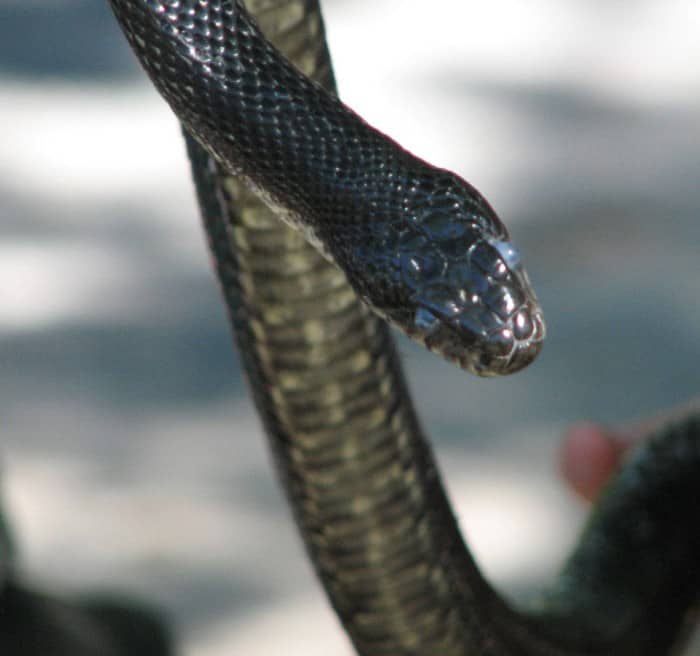
Also known as the black rat snake, black pilot snake and Everglades rat snake (in Florida), the Eastern Rat Snake is a 3 foot to 6 foot long shiny black snake with a medium build.
Adults typically have a white belly with a distinctive black and white checkerboard pattern that turns a stone gray color near the tail. Males and females are identical in coloration, and these snakes have a round eye with a round, black pupil.
Commonly encountered in farm lands, forests and thickets adjacent to tall fields, they are excellent climbers, ones that regularly and to considerable distress invade human residences.
Most often active during the nights of warmer seasons, they persist predominately on a diet of rodents, smaller lizards, and birds along with their eggs. Larger examples will also eat young chickens along with chicks.
These snakes are not aggressive, and will typically freeze when threatened. Further provocation will lead to it to producing a foul smelling musk as well as coiling and striking at the threat.
Ribbon Snake (Various Subspecies)
| Latin name | Thamnophis saurita |
| Range | East of the Mississippi River. |
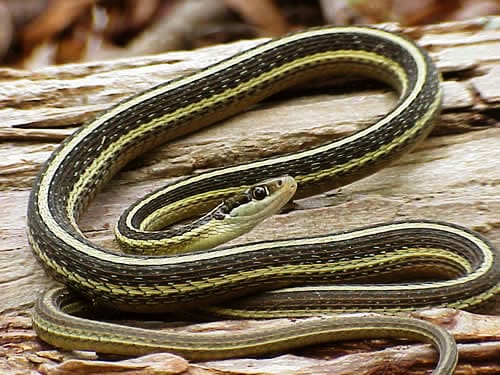
Ribbon snakes are common, small and of very slender build, typically anywhere from 7 inches to almost 3 feet long. Ribbon snakes are named because they are extremely skinny, not for their typical “racing stripes” that go down their flanks.
Brown to dark brown in color, they may have stripes ranging from yellow to blue depending on subspecies.
These snakes are typically encountered near water, often on the edge of wetlands, ponds and streams. They’re good swimmers, and glide across the surface of any calm body of water with ease.
When frightened, they will attempt to flee at all costs, usually retreating towards water or into heavy brush. As a rule these snakes avoid trying to bite, but will if they are handled too roughly they can also emit a foul expulsion from their anal glands.
Northern Red-Belly
| Latin name | Storeria occipitomaculata occipitomaculata |
| Range | North America, parts of the Caribbean. |
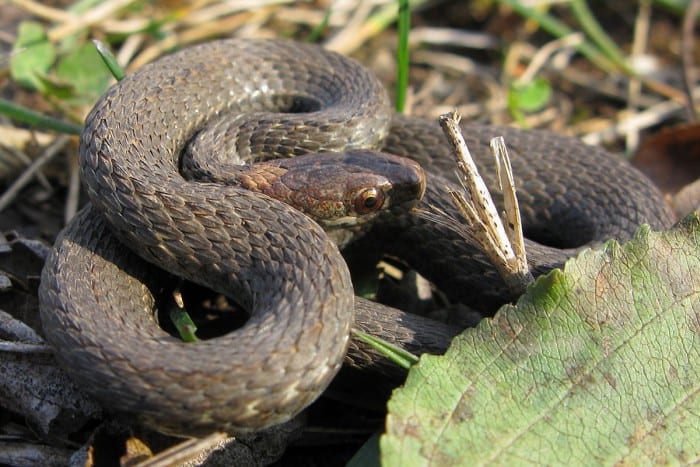
One of the many subspecies of snake that make up the genus containing red-belly snakes as a whole, the Northern Red-Bellied snake is commonly found in moist, loosely packed environments, its favorites being flower beds, dewy woodlands, wetlands and gardens.
There is a high likelihood of finding them under any other obstruction that will make a cool place to rest in between bouts of looking for slugs and earthworms, their primary prey.
Northern Red-Bellies are notable for their striking coloration. On their top and flanks, they range anywhere from a red-brown all the way through a light gray-brown or even jet black, but underneath their bellies are anywhere from a coral red, almost a pink, to a bright brick red.
The snakes are quite small, with adults only rarely exceeding a foot in length.
Milk Snake
| Latin name | Lampropeltis triangulum |
| Range | Range: Majority of continental U.S., southeast Canada, Central- and South America. |
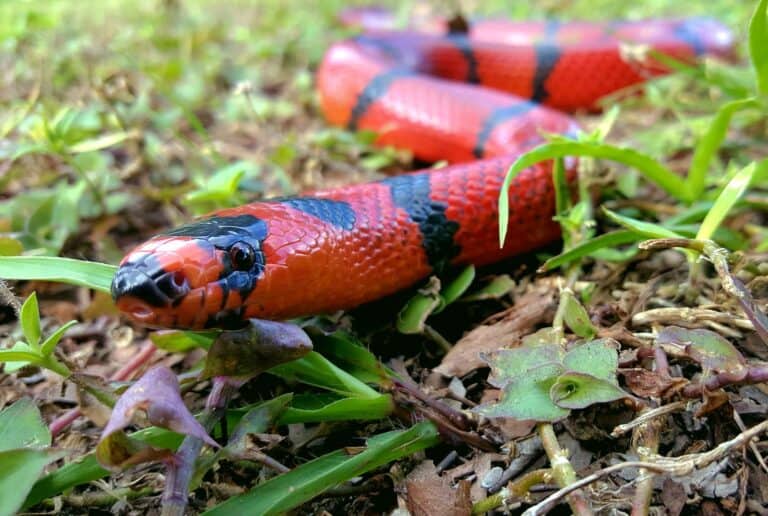
Medium-sized snakes with a striking coloration of red, black and yellow, or red, cream and black, milk snakes are most notable for being close look-alikes with the highly venomous coral snake, with the most typical differences being only that of pattern or color arrangement.
Nonetheless, milk snakes are harmless and can generally be told apart from coral snakes because their red bands typically border their black bands, whereas on coral snakes the red bands border the yellow bands.
This has given rise to a jingle in order to help people remember which snake is which: Red to yellow, kill a fellow; red to black, venom lack.
Note that this is not one hundred percent totally reliable, as some milk snakes have colors that are virtually identical to the coral snake, and some coral snakes lack the usual band patterns.
Milk snakes are generally slow-moving and secretive, preferring to move around only at night, and averaging about 3 feet in length, though some very large specimens can approach 5 feet.
Milk snakes will typically attempt escape when they are threatened or frightened, but if cornered or repeatedly threatened, they make a stand and strike energetically. Some have even been known to vibrate their tails against the ground, leading onlookers to mistake them for rattlesnakes.
Northern Watersnake
| Latin name | Nerodia sipedon |
| Range | Central U.S. through New England and Deep South. |
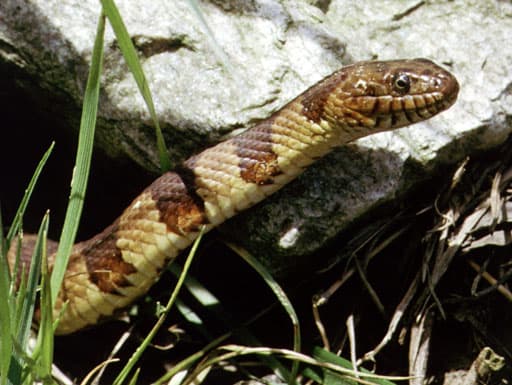
This dark, ruddy-colored snake averages about 2 ½ feet in length, but can grow upwards of 4 ½ feet. It typically has contrasting dark colored blotches across the length of its body and for this reason is commonly mistaken for and targeted as a cottonmouth or copperhead by scaredy cats.
Older snakes continually darken in color and their patterning becomes obscure as they age. The undersides of these snakes may be gray, yellow or off white in color.
These snakes are harmless and non-aggressive, but if picked up or prodded it anyway they will bite repeatedly and thrash, also spraying out a foul smelling musk and feces in the bargain.
When not causing problems after being picked up, the snakes are commonly seen basking in the sun on rocks and logs near wetlands and ponds. As the name suggests, they are excellent swimmers.
Smooth Green
| Latin name | Opheodrys vernalis |
| Range | U.S.-Canada Border regions, much of New England, U.S. Midwest. |
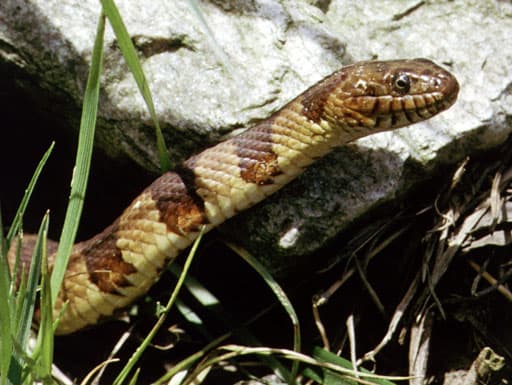
Another small snake rarely exceeding 1 1/2 feet in length with a slender build. It is a uniform light, bright green color with a contrasting yellow or white belly.
These snakes do not take on their characteristic green color until after the first time they shed their skin. They’re bright green scales, which have lent them the common name of grass snake helps them blend into foliage while they hunt.
These snakes are found in a variety of environments throughout the range, but greatly prefer smooth, open ground with little in the way of obstructions or ground clutter.
On defense they will typically flee at best speed, but often can be handled safely, usually settling down after squirming for a short time.
This is another species that can expel a foul musk from their anus when threatened. Notable among snakes, these have fairly good eyesight, if only over short distances.
Common Garter
| Latin name | Thamnophis sirtalis |
| Range | Majority of North American continent, except Southwest U.S. and Mexico. |
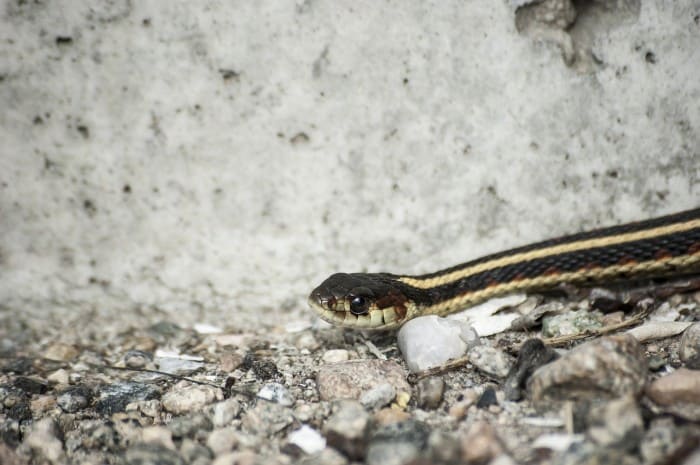
Garter Snakes are common and plentiful snakes found throughout North America, of medium build and length, averaging about 2 feet long. As a rule, they are black, green or brown, and feature yellow stripes running the length of their bodies.
Garter snakes tend to stick near a body of water, but aside from that can be found almost anywhere, from mountains and wetlands to meadows, fields and forests.
Garter snakes have saliva that contains a toxin that helps them take down their prey, typically small mammals and amphibians, and while it is not truly dangerous to humans if you are bitten by one, it might cause additional irritation or swelling at the wound site.
Aside from a potential adverse reaction, they are nowhere near as dangerous as truly venomous snakes found on the continent.
Garter snakes exhibit variable defensive behavior, with some freezing in place to avoid notice, while others will bluff with aggressive posturing before turning passive when touched.
Others are not bluffing and will strike repeatedly and vigorously when threatened. You never know how a garter snake will react!
California Kingsnake
| Latin name | Lampropeltis getula californiae |
| Range | Western U.S. and northern Mexico. |
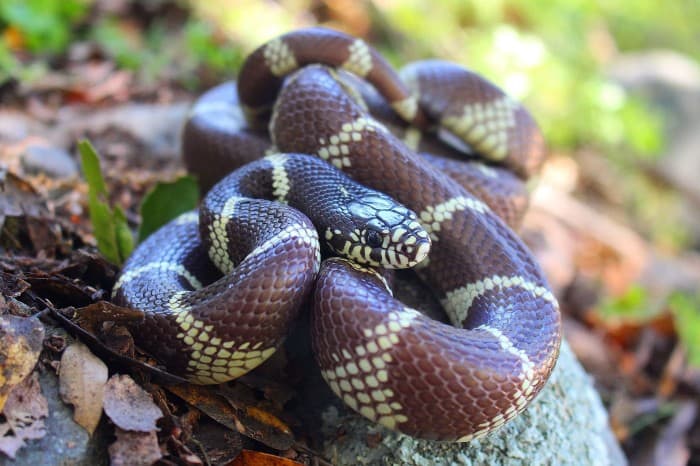
A medium sized snake of striking coloration, the California Kingsnake is found throughout the western United States in abundance as well as northern Mexico.
Possessed of a typically rust-red body with ivory or cream colored bands of variable width along its length, it is sometimes mistaken for the American coral snake.
These snakes are known widely to hunt and kill other snakes as prey, including rattlesnakes, since they are resistant or even immune to their venom. Kingsnakes kill by constriction, and are among the most powerful constrictors in proportion to their body mass.
These cannibalistic reptiles average about 2 feet in length, with a few subspecies growing upwards of 5 feet long. Their abundance and hardiness make them popular pets and they do well in captivity.
Note that, while not aggressive towards people, they will bite readily and often if handled while simultaneously ejecting feces.
Eastern Racer
| Latin name | Coluber constrictor |
| Range | Majority of Continental U.S. and east coast of Northern Mexico. |
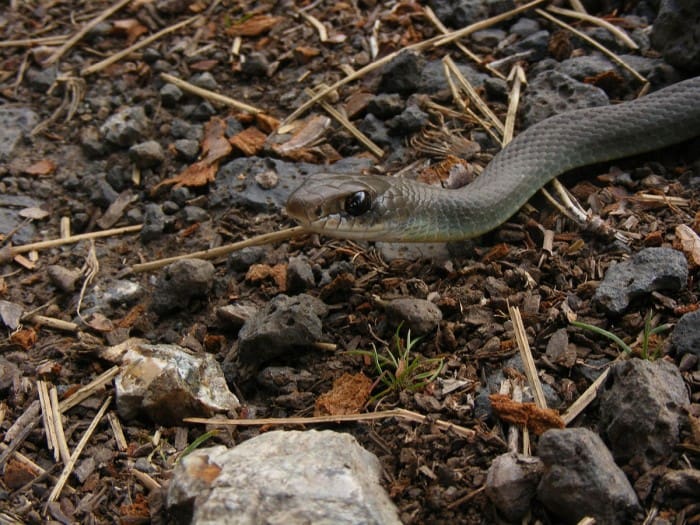
Long, slender and athletic snakes, that are renowned for their speed. Eastern racers, oftentimes called black racers for one typical and common coloration (though they may appear as brown, tan or even blue) are curious snakes that are also excellent climbers, often seen scaling trees in search of prey waiting inside a bird’s nest.
All of these snakes have a light underbelly that simplifies identification.
The snakes are most active during the day, taking it easy and resting during the night. They can be found at turns near water, but also in heavy brush, on the roadside, and near human habitation. This is one of the most common snakes in the American South.
Among snakes they are noteworthy for their excellent vision which they put to good use by lifting their heads off the ground to survey the area around them while traveling.
They rely on their great speed to escape whenever they are threatened or frightened but, if cornered, or handled they will fight back viciously, biting hard in a rapid-fire fashion.
They can also pull a pretty convincing fake-out by vibrating their tails against dried ground clutter, which produces a sound shockingly close to a rattlesnake’s warning buzz.
Coachwhip
| Latin name | Masticophis flagellum Flagellum |
| Range | Southern U.S. |
Noteworthy for being one of North America’s largest snakes, the coachwhip snakes earned their name for their extremely long and slender bodies terminating in long and slender tails, making them appear very much like a braided bullwhip or livestock whip in appearance.
These snakes can easily top 6 feet in length and one record-breaking specimen was just a hair over 9 ft long.
Coachwhips are commonly black or a very dark gray which fades towards a tan or dusky color towards the rear. They can easily blend into the grounds of pine woods, glades and marshlands.
Like the eastern racer, this is another fast, athletic snake that is most often active during the day. It will typically hunt actively with his head raised above ground vegetation looking for visual disturbances.
Also notable is its method of dispatching prey; using it strong jaws it will slam smaller prey against the ground to stun it before swallowing it whole and alive, occasionally even eating other snakes.
This is yet another snake that greatly prefers escape to putting up a fight, but if you ever make the mistake of cornering one they will bite repeatedly and mercilessly.
Queen Snake
| Latin name | Regina septemvittata |
| Range | Temperate U.S. east of the Mississippi. |
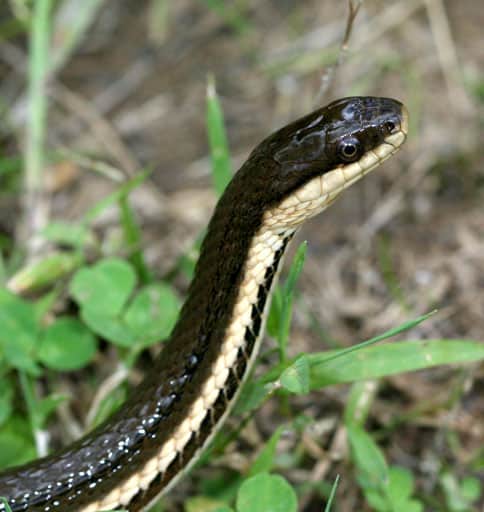
A short species of snake, averaging 2 feet or less, and looking very similar to an average garter snake in coloration with rows of yellow, cream or peach colored stripes running the length of its body.
Queen snakes are notable for their strict environmental requirements, since they feed predominantly on crayfish and will never be found in areas where there are not crayfish in abundance to feast on.
Generally active during the day but occasionally hunting at night, Queen snakes will be found near any freshwater streams with rocky bottoms that are reasonably warm.
Queen snakes are semi-aquatic and are often found basking on branches overhanging water or upon rocks on the water’s edge, quickly retreating into the water when they sense danger.
Assuming you can get close enough to one, they can be handled easily enough since they are fairly docile, but they are quick to emit excrement and a foul-smelling odor when handled.
Corn Snake
| Latin name | Pantherophis guttatus |
| Range | Southern U.S. |
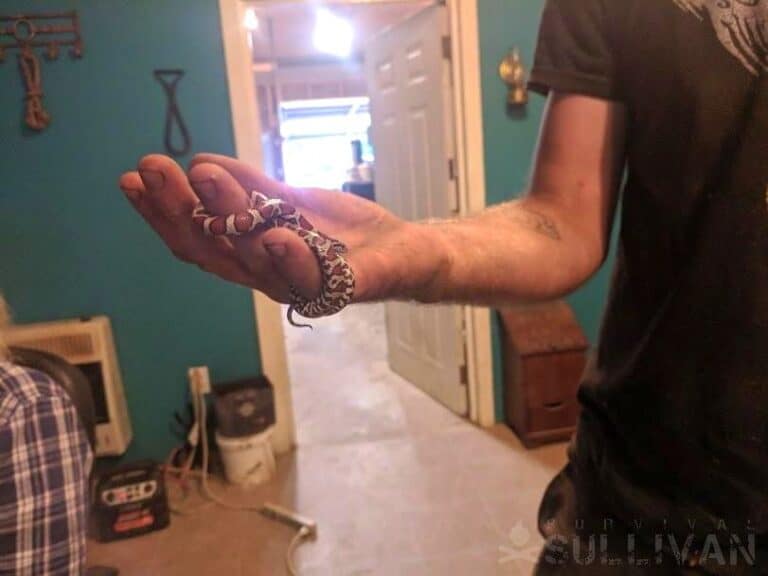
The Corn snake is another non-venomous snake, which can be found throughout the American South, and is so named for its regular appearances near farms that raise and store corn and other grains, since their predominant prey is mice and rats which typically are attracted to and eat such cereals.
Superficially resembling copperheads, Corn snakes are stocky and of greatly variable length, typically found anywhere from 2 feet to 5 feet long. They’re also extremely long lived, commonly surpassing 20 years in captivity.
Corn snakes can commonly be found overgrown fields, undeveloped grass lots, openings in forests and abandoned or scarcely traveled areas in cities. There are most typically found on the ground, but are able climbers.
They hibernate during the winter, but occasionally emerge on warmer days to soak up the sun’s rays. They are popular pets and comparatively docile, tolerating extensive handling well.
Scarlet Snake
| Latin name | Cemophora coccinea |
| Range | U.S., Southern Midwest, Deep South and parts of New England. |
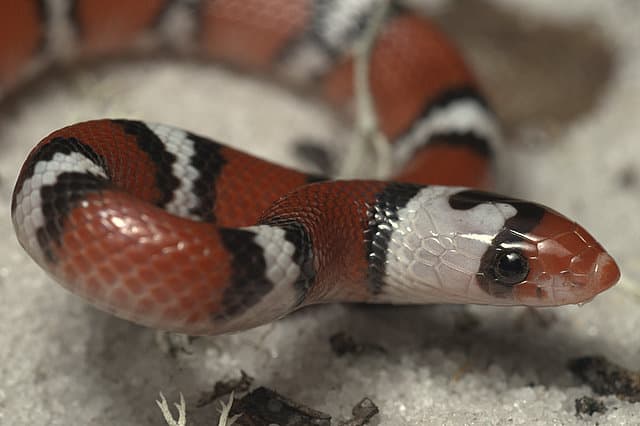
Yet another coral snake look-alike, one that grows anywhere from a foot to just a little over 2 feet long on average and possesses a straight, slight build.
Scarlet snakes are reclusive and often nocturnal, meaning they are rarely seen and they generally spend their time tucked away beneath logs, rocks and heavy ground cover so they do not encounter predators or people very often.
Occasionally, you can find them leaving their burrows in the late evening to begin their nightly search for food.
Scarlet snakes most closely resemble typical coral snakes with a base red color intermingled with alternating thin bands of black and yellow. Unlike coral snakes, their bellies are a giveaway; a uniform pale gray or cream color.
Pacific Gopher Snake
| Latin name | Pituophis catenifer |
| Range | Western North America |
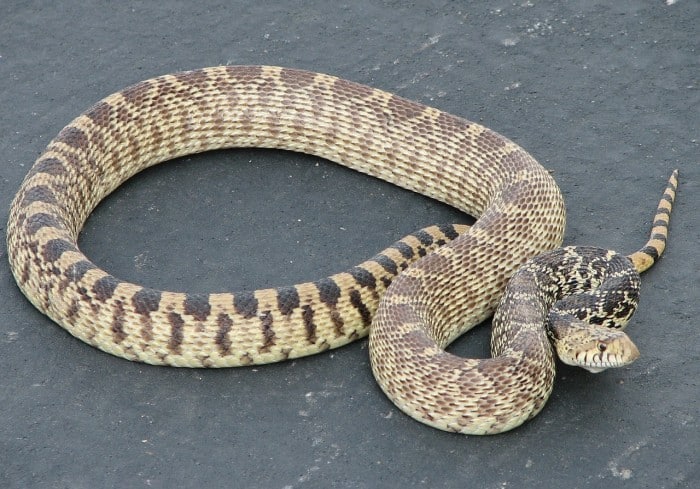
Large and powerfully built snakes that are commonly mistaken for rattlers, gopher snakes are a subspecies of bull snake, so named because their hoarse, brassy hissing sounds similar to that emitted by bulls and cattle.
These big boys often grow to more than 3 feet in length with thick, pudgy bodies and blunt shovel shaped heads.
They may, nonetheless, be easily distinguished from rattlesnakes by the shape of their head which is still narrower than a rattlesnakes and the lack of black and white banding on their tail.
Their typical coloration is a combination of light tans, toasted browns and dark grays or blacks which are arranged in an alternating, rough checker or chain-link pattern. In fact, their scientific name, catenifer, references this; it is Latin for “chain bearing”.
When threatened, the snakes will curl up into the typical S-shaped pre strike pose common to many snakes, but rather than biting, they will thump interlopers with a closed mouth, a sort of reptilian headbutt, to ward off potential predators.
Rubber Boa
| Latin name | Charina bottae |
| Range | Much of western U.S. from Pacific Coast to Utah and as far north as Montana and British Columbia. |
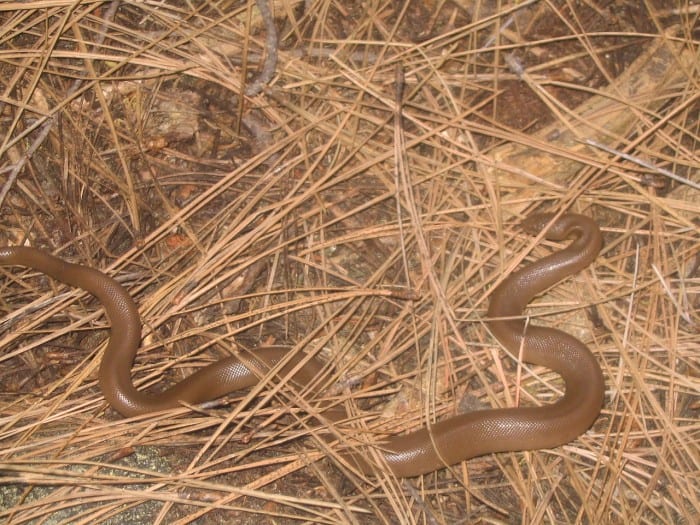
One of two boa species indigenous to the United States, the rubber boa is nonetheless one of the most interesting snakes on the continent.
They are so named for their skin which appears wrinkly and misshapen, and their typical coloration of dark brown fading to tan gives them an outwardly, frankly, fake appearance like that of a rubber snake
These 1- to 2 foot snakes can occasionally be seen with an olive or yellow coloration. They have characteristically chunky bodies but blunt heads, and equally blunt tails. They appear totally unique compared to other snakes and their habitat.
Even more remarkable is that these snakes are incredibly docile, and have a reputation for never biting people under any circumstances. Like many other snakes, they do release the contents of their bowels when threatened in addition to a nasty smelling musk.
They are primarily active in the middle of the night, but can also be found moving around during dawn and dusk. Their typical schedule means they are rarely encountered if one is not searching for them.
Eastern Indigo Snake
| Latin name | Drymarchon couperi |
| Range | Southeastern U.S. |
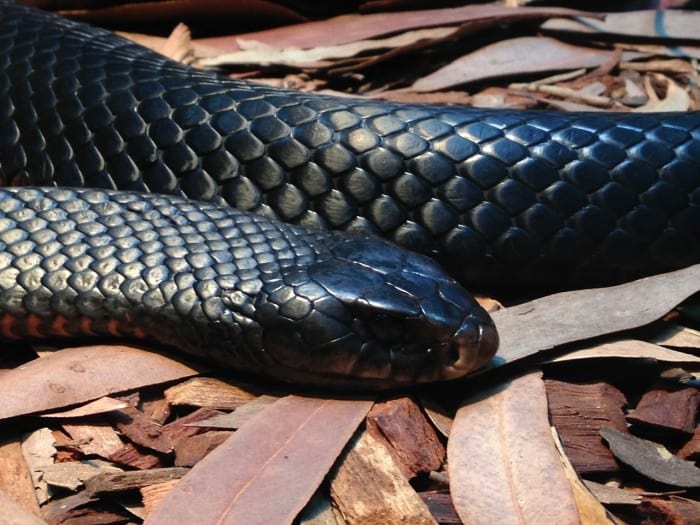
Perhaps the most magnificent of the snakes in North America, the Eastern Indigo is also the longest snake on the continent, a heavy-bodied bruiser of a snake easily reaching over 6 feet in length.
Possessed of iridescent, deep blue-black scales that appear purple in bright light (hence the name) they can be found in many habitats, everything from stream bottoms to sandy fields, dry glades to pine forest.
The snakes are seriously carnivorous, they eat absolutely any other small animal that they can catch and subdue, and are famously known to kill or stun their prey by thrashing it violently against anything nearby, a technique which often results in injury to the snake itself.
On defense, these snakes rely on their maneuverability but, when challenged, they will flatten their neck out, hiss and vibrate their tail against the ground producing a sound similar to a rattlesnake.
Surprisingly though, if picked up they rarely bite, and their striking beauty combined with this entertaining temperament makes them popular pets, though several states require permitting for ownership.
Plains Black-Headed Snake
| Latin name | Tantilla nigriceps |
| Range | Predominately Colorado, Texas, Kansas, Nebraska and Oklahoma, U.S. |
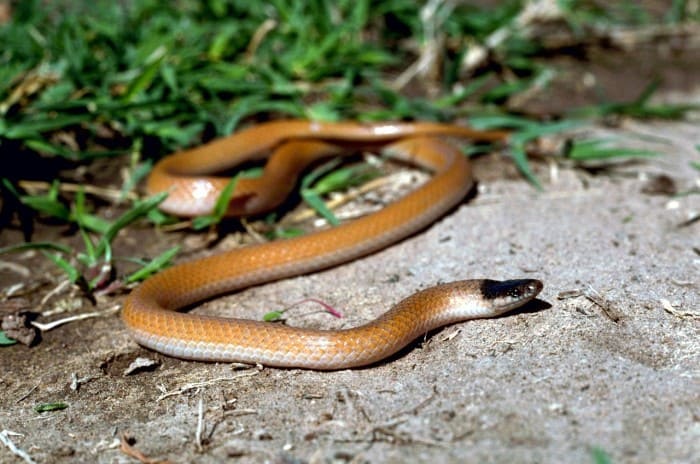
Slender, small, short and striking all describe the Plains Black-Headed Snake.
These little beauties average around a foot in length, and are possessed of striking copper or peach colored scales along their back that transition to white or cream color on their bellies.
Some examples have a distinctly orange stripe running the length of their bodies along their sides. The most distinctive physical feature is the black cap that adorns the top of their heads.
Typically encountered on prairies, be it rocky or grassy, or upon moist hillsides they are occasionally encountered invading human habitation searching for moisture.
These snakes are secretive, and not commonly seen, preferring to stay in safe refuge and during the day away, emerging during the night to hunt.
Noteworthy is the fact that these snakes are vulnerable to dehydration and desiccation, and depend heavily on a moist environment to survive. Ones that remain too long in a dry burrow will typically die in place.
Conclusion
There are an awful lot of snakes on the North American continent, and most of them are non-venomous.
Learning to recognize these non-venomous snakes can only help your efforts to survive when you’re in the middle of a bug-out situation in the deep wilderness or just on your next camping trip.
Give this guide a gander, and find out which snakes are most common in your neck of the woods.
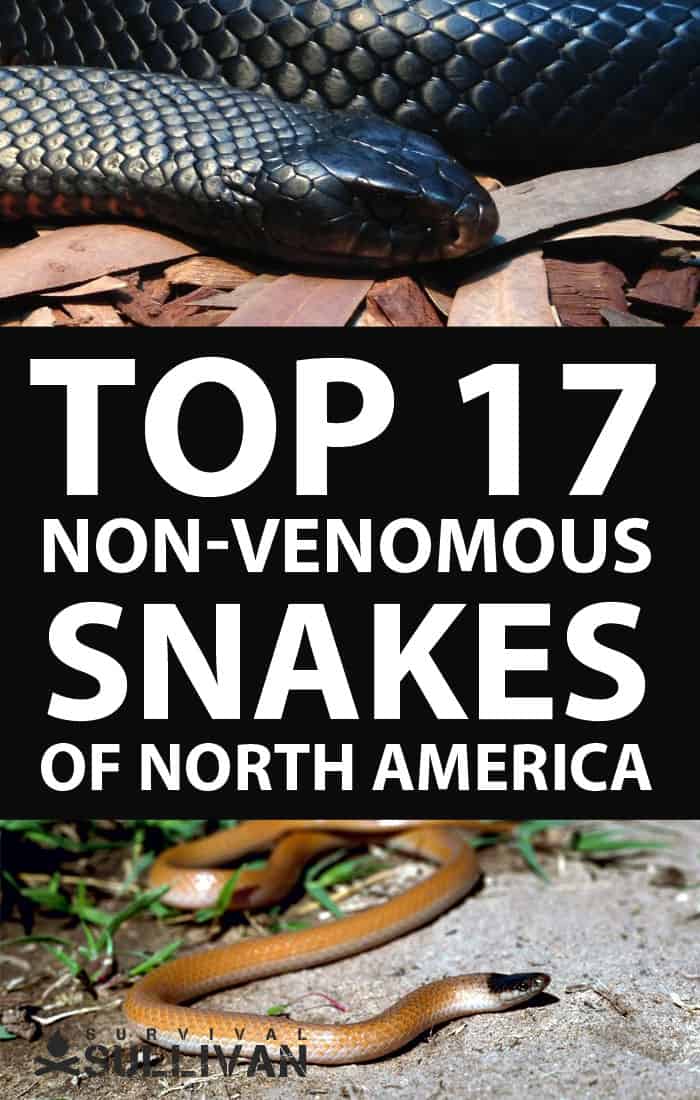

Tom Marlowe practically grew up with a gun in his hand, and has held all kinds of jobs in the gun industry: range safety, sales, instruction and consulting, Tom has the experience to help civilian shooters figure out what will work best for them.
